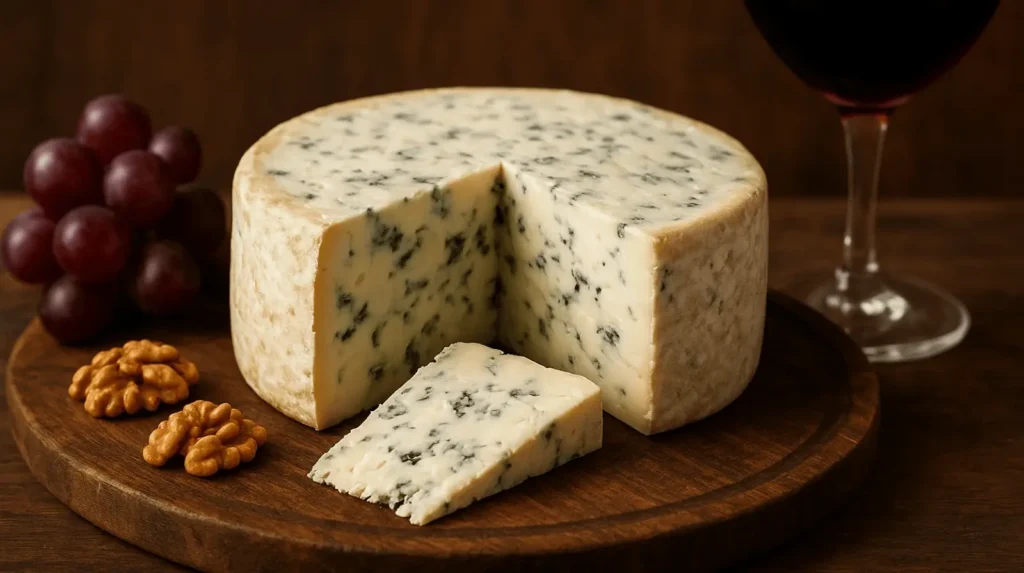Have you heard about Masgonzola? If not, you’re not alone. This unique cheese concept is making waves as a creative take on the world-famous Gorgonzola. Known for its bold blue veins, creamy texture, and tangy flavor, Gorgonzola has long been a favorite among cheese lovers and culinary experts. Masgonzola builds upon this tradition, offering a modern twist that appeals to foodies, chefs, and everyday home cooks.
In this guide, we’ll explore what Masgonzola is, how it differs from Gorgonzola, its flavor and texture, recipe ideas, nutritional benefits, and even where you can buy it. Whether you’re curious about trying something new, looking for inspiration in the kitchen, or researching cheese varieties, this article will give you everything you need to know.
What Is Masgonzola?
Masgonzola is often described as a new-generation version of Gorgonzola cheese. While traditional Gorgonzola is an Italian blue cheese made from cow’s milk, Masgonzola positions itself as a more approachable, versatile option with a slightly milder profile.
Unlike classic Gorgonzola, which has Protected Designation of Origin (PDO) status in Italy, Masgonzola is considered a creative variant. It maintains the essence of Gorgonzola’s creamy, veined appearance but softens its pungent notes to make it more appealing to wider audiences.
In short:
- Gorgonzola: Authentic Italian blue cheese, rich, sharp, and traditional.
- Masgonzola: A creative twist, milder, versatile, and recipe-friendly.
Food, Travel & Unexpected Experiences.
Cheese lovers today not only care about what they eat but also how they enjoy it while traveling. Interestingly, even airlines sometimes make headlines for passenger experiences — like the recent United Airlines Charleston mechanical issue. Food, comfort, and travel often go hand-in-hand.
Origin & Inspiration
To understand Masgonzola, we must first look at Gorgonzola’s history. Originating in Northern Italy, particularly the town of Gorgonzola near Milan, this cheese dates back to the 9th century. Gorgonzola was traditionally aged in caves, where natural molds gave it its signature blue marbling.
Masgonzola, while modern, takes inspiration directly from this Italian heritage. It connects with the blue cheese family—including Roquefort and Stilton—yet seeks to simplify the flavor for today’s global consumers. In other words, Masgonzola pays homage to tradition while catering to modern tastes.
Flavor & Texture Profile
One of the biggest reasons people are drawn to Masgonzola is its flavor balance.
- Flavor: Creamy, slightly tangy, with hints of sharpness but less pungent than classic Gorgonzola.
- Texture: Smooth, spreadable in younger varieties; crumbly yet moist in aged versions.
- Aroma: Subtly earthy but not overpowering.
Quick Comparison: Masgonzola vs Gorgonzola Flavor
| Feature | Gorgonzola | Masgonzola |
|---|---|---|
| Flavor Intensity | Strong, tangy, sharp | Milder, balanced, versatile |
| Texture | Crumbly, creamy | Creamy, spreadable |
| Audience | Cheese enthusiasts | Broader appeal (home cooks) |
Masgonzola vs Gorgonzola
If you’re wondering whether Masgonzola can replace Gorgonzola in recipes, the answer is often yes.
| Aspect | Gorgonzola | Masgonzola |
|---|---|---|
| Origin | Italy (PDO-protected) | Creative/modern adaptation |
| Flavor | Bold, sharp, tangy | Mild, creamy, less pungent |
| Culinary Uses | Traditional Italian recipes, gourmet dishes | Everyday cooking, fusion dishes |
| Availability | Widely available in supermarkets | Specialty stores, select online retailers |
This makes Masgonzola an excellent option for people who enjoy blue cheese flavor but prefer something less intense.
Popular Recipes with Masgonzola
Masgonzola shines in recipes where creamy textures and mild tang are desired. Here are a few ways to enjoy it:
- Masgonzola Pasta: Melt Masgonzola into a cream sauce with garlic, butter, and fresh herbs for a luxurious pasta dish.
- Masgonzola Pizza: Top a thin crust with Masgonzola, caramelized onions, and prosciutto for a gourmet-style pizza.

- Masgonzola Salad: Crumble Masgonzola over mixed greens, pears, and walnuts. Drizzle with balsamic glaze for a perfect balance of flavors.
- Masgonzola Spread: Blend with cream cheese for a delicious spread on bread or crackers.
Tip: If you’ve used Gorgonzola recipes before, you can substitute Masgonzola at a 1:1 ratio for a milder flavor.
How Is Masgonzola Made?
The process of making Masgonzola is inspired by the traditional method of producing Gorgonzola, but with a few modern adjustments to create its milder profile.
- Milk Selection:
Masgonzola usually starts with fresh, high-quality cow’s milk, just like Gorgonzola. The richness of the milk contributes to the creamy texture. - Curdling & Cultures:
Starter cultures and rennet are added to curdle the milk. At this stage, special Penicillium molds (the same used in blue cheeses) are introduced. These molds will later form the characteristic blue-green veins inside the cheese. - Curd Cutting & Draining:
The curds are cut into small pieces and gently drained to remove excess whey, ensuring a smooth consistency. - Salting:
The cheese is salted both on the surface and internally. Salt not only enhances flavor but also controls bacterial activity. - Piercing (Needling):
One of the most important steps! The cheese wheels are pierced with thin needles to allow oxygen inside. This is what helps the blue mold grow and create those beautiful marbled veins. - Aging:
Traditional Gorgonzola is aged for 2–6 months in caves or controlled environments. Masgonzola follows a similar process, but the aging period may be shorter or more carefully monitored to reduce sharpness and keep flavors balanced. - Quality Control:
Finally, each wheel is checked for flavor, aroma, and texture. Masgonzola’s goal is to keep a creamy, milder, versatile profile, making it perfect for a wider audience compared to sharper Gorgonzola.
Homemade Masgonzola-Style Cheese (For Foodies)
While authentic Masgonzola requires professional cheesemaking techniques, you can create a Masgonzola-inspired cheese at home with the right starter cultures:
- Warm 4 liters of whole cow’s milk to about 30°C (86°F).
- Add rennet and a starter culture (available from cheesemaking suppliers).
- Let it set, then cut the curds and drain.
- Sprinkle in blue cheese mold spores (Penicillium roqueforti).
- Press lightly into a mold, salt, and allow it to rest.
- After a few days, pierce the cheese with sterilized skewers to encourage blue veining.
- Age in a cool, humid environment (10–12°C, ~85% humidity) for at least 6 weeks.
This process won’t exactly replicate Masgonzola but gives you a homemade blue-style cheese with a similar creamy-tangy profile.
Health & Nutrition Benefits
Like most cheeses, Masgonzola is packed with nutrients:
- Protein: Supports muscle health.
- Calcium: Strengthens bones and teeth.
- Probiotics: Supports gut health (blue cheese cultures provide beneficial bacteria).
- Vitamins: Contains vitamins A, B2, and B12.
While slightly high in fat, moderate consumption of Masgonzola can be part of a balanced diet. Compared to Gorgonzola, it tends to be slightly lower in sodium, making it appealing to health-conscious eaters.
Where to Buy Masgonzola?
Currently, Masgonzola is available through specialty cheese shops, select online retailers, and sometimes through gourmet supermarkets.
Tips for buying:
- Check online marketplaces like Amazon Fresh or specialty cheese stores.
- Visit Italian delis or gourmet markets in larger cities.
- Look for authenticity labels when buying Gorgonzola or related cheeses.
FAQs
Q1. What is Masgonzola?
Masgonzola is a modern twist on Gorgonzola, offering a milder, creamier flavor profile while retaining its blue cheese essence.
Q2. Can I substitute Gorgonzola with Masgonzola in recipes?
Yes! Masgonzola can be swapped 1:1 in most Gorgonzola recipes, providing a less intense taste.
Q3. Is Masgonzola healthy?
Like Gorgonzola, Masgonzola contains protein, calcium, and probiotics. When consumed in moderation, it can be part of a healthy diet.
Q4. Where can I buy Masgonzola?
It’s found in specialty cheese shops, gourmet markets, and online retailers.
Conclusion
Masgonzola offers an exciting new way to enjoy the classic flavors of Gorgonzola without the intense sharpness that some find overwhelming. With its creamy texture, mild tang, and versatility in recipes, Masgonzola is quickly becoming a favorite for home cooks and chefs alike.
Whether you want to try it in pasta, on pizza, or as part of a salad, Masgonzola brings both flavor and nutrition to your table. For those looking to expand their cheese knowledge and experiment with new varieties, Masgonzola is absolutely worth a try.
